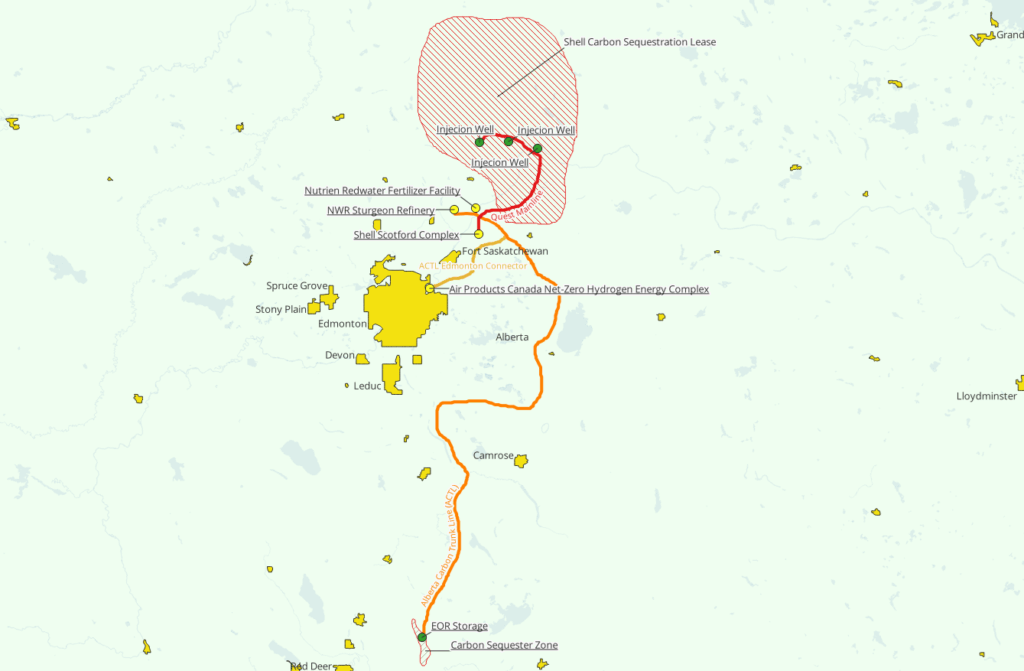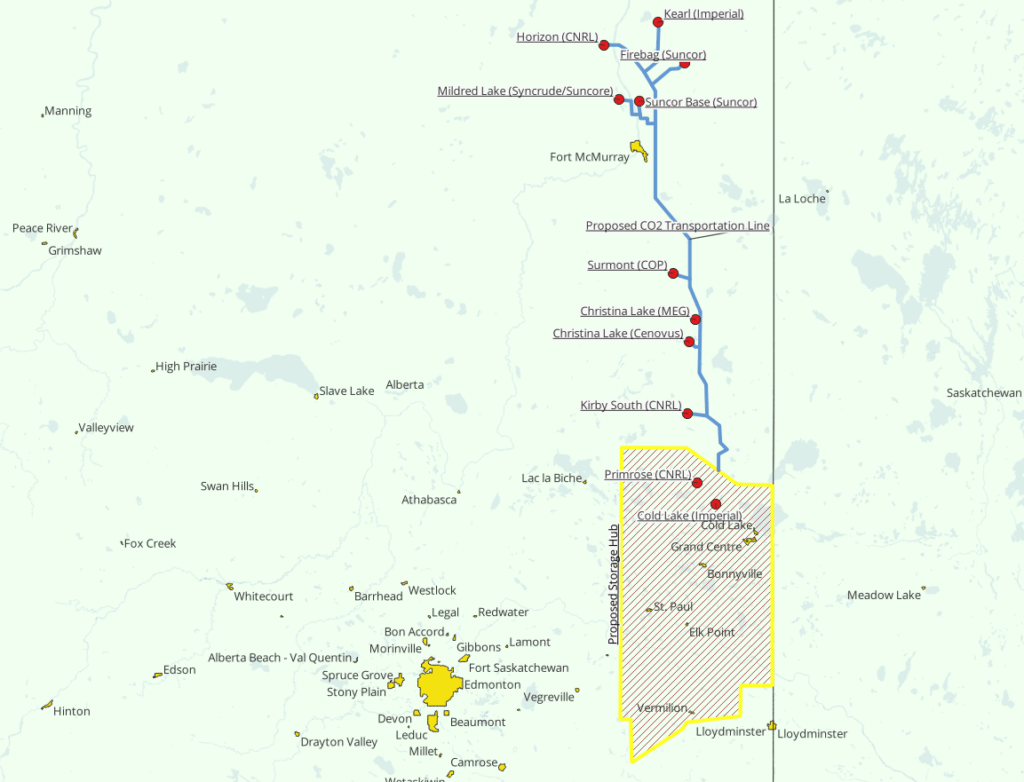October 21, 2025
Alberta CCS
In Alberta, several carbon capture and storage projects are already operating while others are moving through planning stages.
Alberta Carbon Trunk Line
The Alberta Carbon Trunk Line (ACTL), commissioned in 2020, is one of the world’s largest CO₂ transportation systems, with a design capacity of 14.6 MtCO₂/year . Its launch marked a major step in Canada’s efforts to scale carbon capture, utilization, and storage by enabling large‐volume industrial emissions to be permanently sequestered. Currently installed Carbon Capture capacity utilizing ACTL is much lower.
There are a number of current projects utilizing ACTL including:
- NWR Sturgeon Refinery (2020) – Integrated with the Alberta Carbon Trunk Line , the refinery captures 1.6 Mtpa of CO₂ from bitumen upgrading and sends it for EOR.
- WCS Redwater (2020) – This project captures 0.3 Mtpa of CO₂ from hydrogen production, storing it via enhanced oil recovery (EOR) at Redwater, Alberta.
- Enhance Clive Oil Field (2020) – The Clive field acts as a CO₂ storage site through EOR, receiving captured CO₂ via the ACTL pipeline.
Another project not connected to ACTL is Entropy Glacier Gas Plant near Grande Prairie. Entropy began capturing 0.032 Mtpa of CO₂ from natural gas processing, injecting it into deep saline formations. A large wave of large industrial projects which will utilize CCS facilities in Alberta are currently under construction or in development. These include Air Products Blue But Better (2024, 3 Mtpa), Shell Polaris (2025, 0.75 Mtpa), Dow Fort Saskatchewan Ethylene CCS (2027) connected to ACTL, and multiple storage hubs such as Wolf Lamont, Enbridge Wabamun, Alberta Carbon Grid, and Entropy’s Phase 2 Glacier expansion. Other notable large-scale developments include Suncor and ATCO Heartland Hydrogen (2028, 2 Mtpa) and Holcim Exshaw Cement (2030, 1 Mtpa). In total, Alberta has over 40 potential CCS projects at various stages of planning, positioning the province as a leading hub for carbon capture and storage.
Quest CCS Pipeline
The Quest Pipeline (Quest Mainline) showed on Figure 1 is a prominent Canadian carbon capture and storage (CCS) project operated by Shell. It captures CO2 from hydrogen production facilities at Scotford Complex near Edmonton and stores it safely in deep saline formations underground. The project is considered a milestone in reducing greenhouse gas emissions from industrial operations and serves as a model for future CCS initiatives. The Quest CCS facility captures around 1 MtCO₂/year from hydrogen units at Shell’s Scotford upgrader. The CO₂ is transported through a 65 km pipeline and stored in a deep saline aquifer. Quest has become a benchmark project for CCS monitoring and performance in North America.

Figure 1: Alberta Major CO2 Pipelines
Pathways Alliance CCS Project
The Pathways Alliance, which includes Canada’s six largest oil sands producers (Suncor Energy, Canadian Natural Resources Limited (CNRL), Imperial Oil, Cenovus Energy, ConocoPhillips Canada, and MEG Energy.), is developing a regional carbon capture and storage network in Alberta. The project shown in Figure 2 will use a trunk pipeline to collect CO₂ from multiple facilities and inject it into a saline storage hub. This project is a cornerstone of Canada’s decarbonization pathway for the oil sands sector. This CCS network could reduce net CO2 emissions from oil sands operations by approximately 10 to 12 MtCO₂/year by 2030 and as much as 40 MtCO₂/year by 2050. The oilsands currently produces about 68 MtCO₂/year. This project may not only reduce emissions of existing facilities, but also for future potential expansion.

Figure 2: Pathways Alliance Project
References:
“Global Status Report – Global CCS Institute.” Global CCS Institute, 2024, https://www.globalccsinstitute.com/resources/global-status-report/
“Quest Carbon Capture and Storage.” Shell Canada, https://www.shell.ca/en_ca/about-us/projects-and-sites/quest-carbon-capture-and-storage-project.html
“Quest Carbon Capture and Storage Project: Annual Report, 2022 – Open Government.” Alberta Government, August 2023, https://open.alberta.ca/publications/quest-carbon-capture-and-storage-project-annual-report-2022
“Quest Carbon Capture and Storage Project: Annual Report, 2023 – Open Government.” Alberta Government, March 2024, https://open.alberta.ca/publications/quest-carbon-capture-and-storage-project-annual-report-2023
“Alberta Carbon Trunk Line now fully operational.”, Global CCS Institute, June 2020, https://www.globalccsinstitute.com/news-media/latest-news/alberta-carbon-trunk-line-now-fully-operational/
“Pathways Alliance | Net-Zero Emissions from Oil Sands by 2050.” Pathways Alliance, https://pathwaysalliance.ca/ . Accessed 23 September 2025.
Beer, Mitchell. “Pathways CCS Project Won’t Break Even Without Efficiency Gains, Steadier Revenue: IEEFA.”, The Energy Mix, January 2025, https://www.theenergymix.com/pathways-ccs-project-wont-break-even-without-efficiency-gains-steadier-revenue-ieefa/
Pathways Alliance. “Pathways Alliance advances key oil sands CO2 emissions reduction activities.”, Cision, November 2025, https://www.newswire.ca/news-releases/pathways-alliance-advances-key-oil-sands-co2-emissions-reduction-activities-860332032.html
“Multi-Billion Dow Chemical Investment Pegs Alberta as a Top Spot for Low Carbon Plastics Production.”, EnergyNow, January 2025, https://energynow.ca/2024/01/multi-billion-dow-chemical-investment-pegs-alberta-as-a-top-spot-for-low-carbon-plastics-production/

